The combustion mode of oxyfuel combustion (also known as pure oxygen combustion) technology is fuel + oxygen, which eliminates the high energy consumption and NO pollution caused by nitrogen in air-assisted combustion technology. With the development of oxygen production technology and the reduction of electricity costs, pure oxygen combustion technology composed of oxygen + fuel has become a better choice in glass melting furnaces to replace the conventional combustion method composed of air and fuel. This is because pure oxygen combustion has unique advantages in many aspects such as environmental protection, energy saving, output, quality, reducing equipment investment and saving plant space.
1. Characteristics of oxy-fuel combustion glass furnace
2. Common problems of oxy-fuel combustion
3. Construction of Key Parts in Oxy-fuel Furnaces
4. Furnace Heating for Oxy-fuel Furnaces
5. Thermal Insulation of Oxy-Fuel Furnaces
6. Outlook
1. Characteristics of oxy-fuel combustion glass furnace
First, compared with traditional air-assisted combustion furnaces, oxy-fuel combustion glass furnaces do not have a huge regenerator with a large amount of refractory materials, but a flue with a simpler structure. Secondly, the structure and material of the arch are essentially different. The arch of traditional air-assisted combustion furnaces is mostly made of silica bricks, which are mainly built with slag-biting masonry. The thickness of silica bricks is mostly 300-500 mm, and the mud joints are 1-2 mm.
Oxy-fuel combustion furnaces mostly use fused bricks as the main material of the arch, and the materials are mostly fused cast AZS blocks, fused cast α-β blocks, and fused castβ blocks. They adopt a pre-assembled mode, single rings do not bite slag, and dry masonry has no mud joints. Since most daily-use glasses contain alkaline components, and the water vapor concentration in the combustion exhaust gas of the full-oxygen combustion furnace is more than 7 to 8 times that of the ordinary air-assisted combustion furnace, the flame space and flue parts are very likely to form alkaline atmosphere and alkali liquid, which will corrode traditional acidic materials such as silica bricks more severely. Therefore, the refractory materials of the flame space are mostly neutral or alkaline materials, such as: fused cast AZS blocks,fused cast α-β blocks, fused cast β blocks, sintered AZS blocks, zirconium mullite bricks, corundum mullite bricks, chrome corundum bricks, etc. The masonry method combines dry masonry and traditional masonry, which puts forward new requirements for the design of expansion volume and the control of masonry.
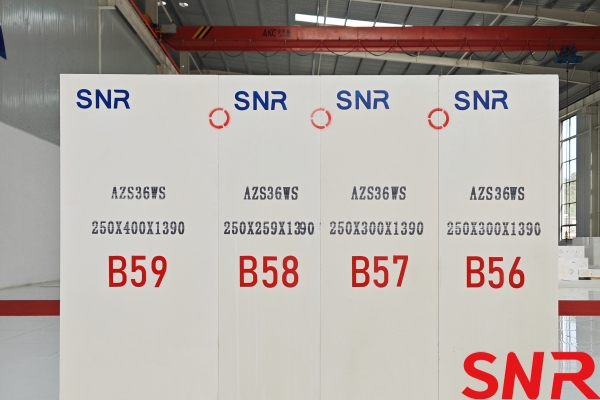

2. Common problems of oxy-fuel combustion
As an emerging technology in recent years, there are relatively few technical teams in China that fully master the design of oxy-fuel combustion glass furnaces, selection of refractory materials, pre-assembly, furnace masonry, furnace loading, heat protection, etc., and relevant domestic standards are also in the drafting stage. In recent years, there have been some accidents and detours in the oxy-fuel combustion glass furnaces operating in various places. The main problems of oxy-fuel combustion glass furnaces at present are:
① The quality of glass does not meet the design requirements;
② The energy consumption level does not meet the design indicators;
③ The furnace service life is short and the economic goals cannot be achieved;
④ In terms of environmental protection, individual projects are difficult to meet the NO standard;
⑤ In terms of production safety, there are problems such as explosion, tempering, and burning to the valve group;
⑥ In terms of furnace safety: crown collapse; material leakage from the side wall, throat, and doghouse; breast wall burns through;liquid leakage from the tank bottom. In terms of glass furnace construction, only the construction of different parts such as the crown is explained.
Compared with traditional air-assisted combustion glass furnaces, the crown of the oxy-fuel glass furnace is dry-laid, without mud joints and no slag bite, so once a problem occurs, it is fatal to the glass furnace.
From the perspective of glass furnace safety, the severity of the problems is as follows:
① Crown collapse, tank bottom leakage;
② Side wall, throat,doghouse, working pool or distribution channel leakage;
③ Gable, breast wall, flue, tuck stone penetration;
④ Feeder, charger scouring, leakage.
In the treatment of the crown, the particularity of the brick and steel structure dry-laid arch determines that any problem in any part is almost impossible to repair, so the masonry of the all-oxygen glass furnace crown is more critical and should be given special attention.
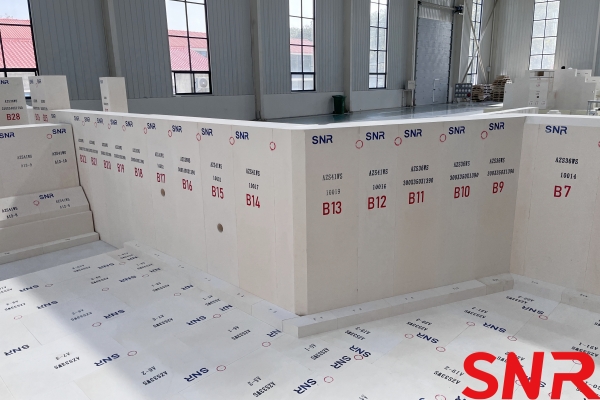

3. Construction of Key Parts in Oxy-fuel Furnaces
3.1 Fabrication and Installation of Steel Structures
The primary role of the steel structure in oxy-fuel furnaces is to support and secure the refractory materials, which is fundamentally no different from traditional air-fuel furnaces. However, due to the unique characteristics of the large crown construction in oxy-fuel furnaces—such as the single-ring crown construction without interlocking bricks—the installation and adjustment of the crown skewback often require a separate adjustment mechanism. The treatment of steel structures in other parts of the glass furnace is generally the same as in traditional air-fuel glass furnaces.
Although the bulk density of fused cast materials is relatively high, the design thickness of the crown is thinner compared to silica bricks, and the span of the crown is somewhat smaller. As a result, the overall weight of the crown in oxy-fuel furnaces of comparable scale is similar to that of traditional air-fuel furnaces. This similarity means that the selection of materials for columns and rear support beams does not require significant additional design considerations.
In most oxy-fuel furnaces, the breast wall and crown are independent structures, and the column spacing is not very large. Therefore, the breast wall plate and lower support brackets do not need to be enlarged compared to traditional air-fuel glass furnaces.
Issues such as column deformation or bending of adjusting screws during the steel structure selection or furnace heating process are addressed in the same manner as in traditional glass furnaces.
3.2 Construction of the Crown
In oxy-fuel glass furnaces, the crown is typically constructed using fused cast materials and dry stacking methods, which significantly differ from the mortar-based construction of traditional silica brick crowns. A typical structure of a fused cast material crown is shown in Figure.
To ensure consistency (curvature, arch height, and span) between each ring, refractory material manufacturers must conduct pre-assembly in the factory. During pre-assembly, any identified issues should be corrected. Once the design requirements are met, joint alignment marks are sprayed on the designated positions of the blocks, and detailed records of the crown assembly data are made.
Pre-assembly is a critical step and is usually performed by experienced assembly workers. Specialized tools should be used during assembly to avoid damaging the blocks. Pre-assembly is carried out on an assembly platform equipped with a flat surface, clamping devices, support mechanisms, and assembly arch templates.
The assembly arch template is an essential tool used by refractory manufacturers for pre-assembly and is also crucial for the on-site construction of the crown. Typically, the same set of arch templates is used for both pre-assembly and construction to avoid mismatches caused by using different templates. Common types of arch templates include steel, wood, and earthen/stone templates. Regardless of the type, the arch template must ensure reliability and stability.
During the crown construction, the construction team should follow the pre-assembly data provided by the refractory manufacturer. The first step to ensuring construction quality is the proper installation of the arch template, ensuring it is level and plumb. When installing the final locking brick of each ring, it is essential to maintain consistent gaps and uniform drop height (the decrease in arch height after removing the arch template) to ensure the consistency of the arch height. Figure illustrates the critical dimensions and requirements for crown construction.
4. Furnace Heating for Oxy-fuel Furnaces
Currently, most oxy-fuel furnaces primarily use hot air heating for the furnace heating process. In some cases, oxy-fuel burners are directly used for heating, but this is typically limited to smaller-scale furnaces and is not widely applicable. Hot air heating, also known as rapid heating, involves the use of specialized heating equipment to blow excess heated combustion air into the glass furnace. This technology emerged in the United States in the 1960s and was introduced to China in the mid-to-late 1980s, where it quickly gained widespread adoption.
Main Equipment for Hot Air Heating:
Multiple heating equipment units
Supporting fans
Control cabinet
Burner front-end components (pressure stabilizing valves, ball valves, needle valves for adjustment, check valves, flow meters)
Supporting thermocouples and wiring
Portable furnace pressure measuring instruments
Handheld infrared thermometers (one for high temperature and one for low temperature)
Mercury thermometers
Heating Tools:
Adjusting screws
Tie rod wrenches (or pipe wrenches)
Lever bars
Wooden mallets
Lubricants
Flashlights
Markers
Measuring scales
Iron wires and chains
High-temperature blankets
Welding machines
Gas cutting tools
Iron hooks
►A schematic diagram of hot air heating equipment is shown in Figure.
Compared to traditional heating methods, hot air heating technology offers the following advantages:
Uniform heating temperature and even expansion across all parts of the glass furnace.
Faster heating, saving time and fuel.
Precise control of heating rates, achieving an accuracy of ±2.5°C.
Reusable heating equipment.
Stable transition during the "over-fire" phase.
Positive pressure heating, preventing cold air ingress and avoiding block cracking.
Enhanced glass furnace safety.
Easier automation of the heating process.
4.1 Adjustment of steel structure
Different from traditional glass furnaces, the adjustment of steel structure is mainly concentrated on the steel structure of the arch. There are two ways to adjust the arch: tension and top screw adjustment.
This mainly depends on the column fastening method adopted by the glass furnace designer according to the glass furnace span size and material selection. The adjustment of steel structure should strictly follow the furnace heating plan, and be adjusted according to the characteristics of different parts and different refractory materials combined with the heating curve. In principle, frequent adjustment and less adjustment should be guaranteed.Combined with the glass heating workers‘ experience of the tension of tension and top screw, the tightness of steel structure should be matched with the expansion amplitude of refractory materials. The steel structure adjustment of the arch should be adjusted in combination with the arch height data and the cracking degree of the upper part of the arch, so as to ensure that the arch block is slightly opened upward in the end, and the opening width is preferably controlled within 0-3 mm.
Note that when the glass furnace is heated up, the lower opening of the arch block will cause the stress point of the arch to be concentrated on the upper part, which is very likely to cause the arch to collapse. Figure shows two common arch support steel structures.
The adjustment of the arch is comprehensively
judged by the arch rise and upper opening data, and the upper opening of the arch when the steel structure is finalized after the glass furnace is heated is used as the judgment standard.
4.2 Establishment of the Temperature System
The heating curve is determined based on the selection of refractory materials. Key stages to pay attention to include: the moisture removal phase, the transition to full firing phase, the refractory shrinkage phase, and the steel structure stabilization phase.
(1) Moisture Removal Phase (Around 200°C):
This stage focuses on removing internal moisture from the refractory materials to prevent cracking caused by rapid heating due to trapped moisture. The moisture removal phase typically requires a holding time of 4 to 8 hours.
The sources of moisture inside the furnace include:
Cooling water from the processing of fused cast bricks.
Water in the mortar used during furnace construction.
Water in ramming and castable materials.
Moisture absorbed by refractory materials due to humid weather.
Different furnaces may exhibit varying behaviors during the moisture removal phase depending on factors such as geographical location, construction timing, and the interval between construction completion and heating. On-site personnel must closely monitor the process. In some cases, significant moisture release may occur even at 300°C, necessitating adjustments to the heating plan.
(2) Transition to Full Firing Phase (1000°C ± 50°C):
This stage, also known as the "over-fire" phase, involves switching from hot air heating to oxy-fuel burner heating. A transition period of 4 hours is typically planned. During the switch, operators must closely monitor changes in furnace pressure and adjust accordingly, as the flue gas volume will significantly decrease. After switching to oxy-fuel burners, attention should be paid to maintaining uniform furnace temperature to avoid localized overheating or underheating, which could affect the overall expansion of the furnace.
(3) Steel Structure Stabilization and Zirconia Seal Sintering Phase (1300–1350°C):
This stage involves the stabilization of the steel structure and the sintering of zirconia sealing materials. Some fused cast materials may undergo noticeable shrinkage during this phase, requiring close monitoring of steel structure adjustments. A holding time of 8 hours is typically planned. After this stage, the steel structure is generally stabilized, with only minor adjustments needed in specific areas.
(4) Batch Charging Phase (1350–1600°C):
The batch charging phase varies depending on the product being manufactured. Initially, cullet (crushed glass) is charged, either manually or by blowing. When the liquid level reaches 300 mm below the production level, the charging process switches to a batch charger, transitioning from pure cullet to a mixture of cullet and raw materials. This allows for normal production to begin as soon as possible.
Some furnaces may include a soaking period (typically around 8 hours) before full production, while others may proceed directly to production without soaking.
4.3 Heating Rate
The heating rate must be determined based on the expansion characteristics of the glass furnace‘s main materials. It is crucial to ensure stable heating at critical points and allow sufficient time for the adjustment of the steel structure. During the glass furnace heating process, on-site engineers should adjust the heating progress in a timely manner according to the specific conditions.
4.4 Countermeasures for Abnormal Situations
In a 2011 project, due to incorrect thermocouple calibration connections, there was a significant deviation between the displayed temperature and the actual temperature in the glass furnace. This directly resulted in the majority of the tie rods becoming locked and unable to loosen, while the crown continued to rise. The measures taken were to stop heating and maintain the temperature for 36 hours, strengthen the insulation of exposed refractory materials, and resume heating only after the temperatures stabilized.
In 2021, a factory used fused materials produced by a small manufacturer. Due to the substandard quality of these materials, the expansion of the crown deviated significantly from the theoretical curve. Under the precise monitoring and guidance of on-site engineers, the heating plan was adjusted multiple times, ultimately achieving the glass furnace heating goals.
In a 2018 project, the factory was located in a southern region, and the glass furnace was heated immediately after completion of the brickwork. When the temperature exceeded 200°C, there was significant water drainage from the glass furnace bottom. This issue was resolved by extending the insulation time to allow for proper drainage.
5. Thermal Insulation of Oxy-Fuel Furnaces
5.1 Characteristics of Thermal Insulation in Oxy-Fuel Furnaces
(1) Treatment of Expansion Joints
The treatment of sintering materials and insulation materials in oxy-fuel furnaces is generally similar to that in traditional glass furnaces. This section specifically focuses on the treatment of expansion joints in fused cast materials.
When designing the structure of fused cast materials, different design units should fully consider the expansion characteristics of the materials and reserve appropriate allowances during the design phase. If the allowance is too large, it may be difficult to fully close the joints by the end of the glass furnace heating process, leading to potential fire penetration during long-term operation. If the allowance is too small, the joints may become over-compressed during heating, potentially causing arching or even damage to the blocks, making subsequent heat treatment more challenging.
As the construction unit, special attention should be paid to material selection, construction sequence, and key treatment points to properly handle expansion joints.
(2) Insulation Coatings
As the final barrier for furnace insulation, insulation coatings play a crucial role. Proper application of insulation coatings can significantly enhance the energy efficiency of the glass furnace.
Due to excessive competition in the market, the quality and price of insulation coatings vary widely.
The application of insulation coatings should be carried out after the glass furnace charging is completed. At this stage, the steel structure of the glass furnace has already stabilized, and there will be no significant changes. This ensures that the insulation coatings remain relatively stable and achieve the desired results.
Key Construction Points:
In addition to large-area coverage, the coverage of side joints is equally important.
For vertical surfaces, multiple layers of coating should be applied.
The thickness of the coating, depending on the design requirements and the quality of the insulation coating, generally ranges from 30 to 150 mm.
5.2 Post-Operation Maintenance
Since the water vapor concentration in the flue gas of oxy-fuel furnaces is much higher compared to traditional air-fuel furnaces, the viscosity of the glass surface is relatively lower. Additionally, to improve melting efficiency, local temperatures may be higher. Therefore, during the post-operation maintenance of the glass furnace, special attention should be paid to the phenomenon of glass penetration through the joints of the sidewall blocks. Any issues should be addressed early to avoid accidents.
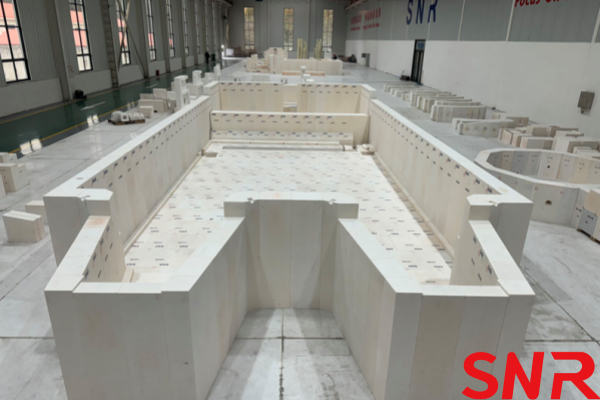

6. Outlook
For oxy-fuel furnaces, since the flame space is often constructed using dry-laid fused cast refractory materials, higher requirements are placed on the treatment of expansion joints and the adjustment of the steel structure during the furnace heating process. Although hot air heating can achieve relatively balanced internal temperatures when using high air volumes for combustion, the continuous development of special glass furnaces has raised the bar for furnace construction and heating technologies.
6.1 Advancements in Furnace Heating Technology
(1) Deployment of More Heating Equipment
To achieve more uniform temperatures, additional heating equipment is typically installed in various parts of the glass furnace based on its structure. Combined with temperature measurement data, these heaters are individually adjusted to obtain more consistent heating results.
(2) Automatic Control Systems
Modern heating systems incorporate more monitoring points (including denser thermocouples, furnace pressure sensors, and optical pyrometers) to ensure accurate data collection.
The automatic control system adjusts the fuel consumption and blower air volume of heaters at different locations based on the collected data from various parts of the glass furnace. If the target temperature exceeds the set heating plan, the system will issue an alarm, prompting on-site personnel to intervene manually.
6.2 Application of New Technologies
(1) Application of Electrode Coatings
Traditionally, molybdenum electrodes were pushed into position only after the glass liquid level reached a predetermined point. However, plate electrodes and mushroom-head electrodes must be pre-installed inside the glass furnace or forehearth. Previous methods involved covering them with fiberglass cloth and water glass, which carried certain risks. Some projects filled the furnace with cullet before heating to perfectly protect the electrodes from oxidation, but this approach extended the heating time and made cost control difficult.
With the advent of high-temperature coating technology, these issues have been resolved. Many domestic companies have now mastered high-temperature coating techniques for electrodes, providing more options for the development of special glass furnaces.
(2) Application of Internal Refractory Coatings
Internal furnace coating technology, developed in recent years, involves spraying nano-molecular materials onto the interior of the furnace (primarily the refractory materials in the flame space). This enhances thermal reflectivity, increases the surface density of the refractory materials, reduces erosion rates, and extends furnace life.
Currently, silicon-based, corundum-based, zirconia-corundum-based, and alumina-silica-based spray materials are being used in production practices.
History is evolving, and technology is advancing. As more visionaries invest in the field of oxy-fuel combustion technology, oxy-fuel furnaces will undoubtedly see faster development in the glass industry, driving the application of more advanced technologies and equipment. Lower energy consumption, reduced emissions, better product quality, improved economic efficiency, longer furnace life, and more reasonable construction and operating costs remain the industry‘s ongoing goals.
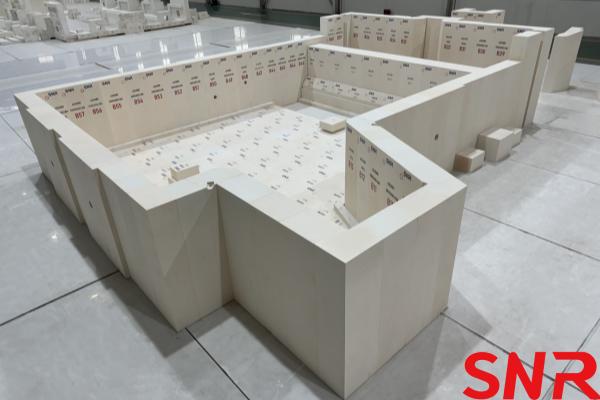

Summary
Oxy-fuel combustion technology, which uses fuel and oxygen instead of air, has become a preferred choice in glass melting furnaces due to its environmental, energy-saving, and operational advantages. This article explores the characteristics, construction, heating methods, and future outlook of oxy-fuel combustion glass furnaces.
1. Characteristics of Oxy-Fuel Combustion Glass Furnaces
Oxy-fuel furnaces differ significantly from traditional air-fuel furnaces. They eliminate the need for large regenerators and use simpler flue structures. The crown is typically constructed with fused cast materials (e.g., AZS blocks) in a dry-stacked, pre-assembled manner, without mortar joints. This design requires careful handling of expansion joints and steel structure adjustments during heating. The high water vapor concentration in the exhaust gas and the alkaline environment necessitate the use of neutral or alkaline refractory materials to resist corrosion.
2. Common Problems in Oxy-Fuel Combustion
Despite its advantages, oxy-fuel combustion faces challenges such as:
Quality and energy consumption issues: Glass quality and energy efficiency may not meet design expectations.
Short furnace lifespan: Premature wear and tear can lead to economic losses.
Environmental and safety concerns: High NOx emissions, explosions, and furnace leaks (e.g., crown collapse, sidewall leakage) are significant risks.
Construction and maintenance complexities: The dry-stacked crown and unique refractory materials require precise construction and heating processes.
3. Construction of Key Parts in Oxy-Fuel Furnaces
Steel Structure: Supports the furnace and adjusts for thermal expansion. The crown‘s dry-stacked design requires specialized adjustment mechanisms.
Crown Construction: Pre-assembly of fused cast materials is critical to ensure uniformity. Proper alignment and locking of bricks are essential to prevent structural failures.
Expansion Joints and Insulation: Careful design and application of insulation coatings are necessary to manage thermal expansion and improve energy efficiency.
4. Furnace Heating Methods
Hot Air Heating: The most common method, offering uniform heating, faster heating rates, and precise temperature control. It ensures stable transitions during the "over-fire" phase and prevents cold air ingress.
Heating Curve and Steel Structure Adjustment: The heating process includes moisture removal, transition to full firing, steel structure stabilization, and batch charging phases. Proper adjustment of the steel structure and monitoring of expansion are critical to avoid structural damage.
Handling Abnormalities: Issues such as thermocouple errors, material quality defects, and moisture drainage must be addressed promptly to ensure safe and efficient heating.
5. Thermal Insulation and Post-Operation Maintenance
Insulation Coatings: Applied after charging to enhance energy efficiency and protect refractory materials.
Maintenance Challenges: High water vapor concentration and localized high temperatures increase the risk of glass penetration through joints, requiring early detection and repair.
6. Future Outlook
Advancements in Heating Technology: Deployment of more heating equipment and automated control systems will improve temperature uniformity and operational efficiency.
New Technologies: High-temperature electrode coatings and internal refractory coatings (e.g., nano-molecular materials) will enhance furnace performance, reduce erosion, and extend furnace life.
Industry Goals: Continued development of oxy-fuel combustion technology aims to achieve lower energy consumption, reduced emissions, better product quality, and longer furnace lifespans.
In conclusion, oxy-fuel combustion glass furnaces represent a significant advancement in glass manufacturing, offering environmental and operational benefits. However, their unique design and construction require specialized knowledge and careful handling. With ongoing technological advancements and industry collaboration, oxy-fuel furnaces are poised to play a pivotal role in the future of glass production.
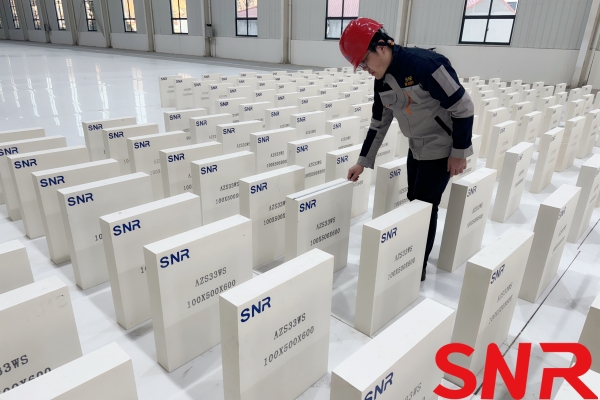

Henan SNR Refractory Co., Ltd. has been specializing in the production of fused cast AZS blocks for about 25 years. We use high-quality raw materials and advanced fusion technology to provide customers with high-quality products. From raw material procurement to finished product delivery, every step is strictly quality inspected to ensure that every indicator meets the standards, so you can use it with confidence.
 If you have any needs, you can contact me at any time.
If you have any needs, you can contact me at any time.
Web:www.snr-azs.com
Email:wendy@snrefractory.com


